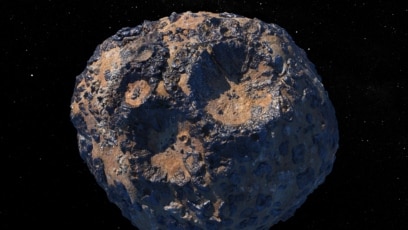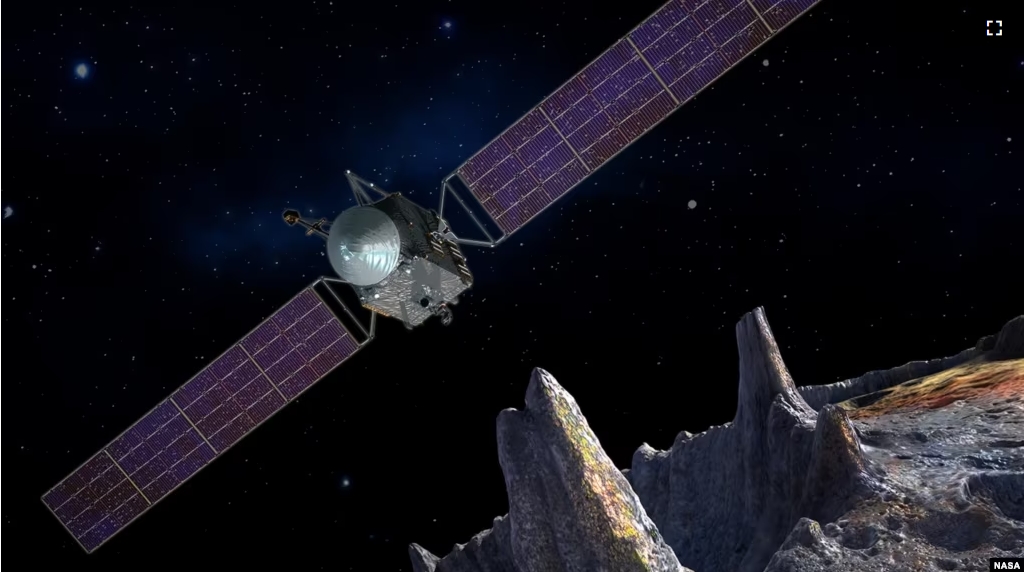The American space agency NASA is preparing to launch a spacecraft designed to observe an asteroid made mostly of metal.
The launch of the vehicle, called Psyche, is set for October 12 from Kennedy Space Center in Florida.
The spacecraft will fly to an asteroid also called Psyche. It orbits the sun between Mars and Jupiter. NASA says the asteroid was discovered by an Italian astronomer in 1852. Since it was the 16th asteroid discovered, it is sometimes also called 16 Psyche.
Psyche will be NASA’s first trip, or mission, to an asteroid that contains a large amount of metal. Past missions explored asteroids made mostly of rock or ice.
Astronomers say the asteroid Psyche is about 280 kilometers at its widest point. They believe it may be part of a center, or core, of a planetesimal. This is an object thought to be the metallic remains of an early rocky planet. Scientists think Psyche is made up mostly of iron and nickel, similar to Earth’s center.
NASA believes the asteroid could have separated during violent crashes that happened during our solar system’s early creation. Scientists think data collected on the asteroid could provide new details about how rocky planets, including Earth, formed.
But NASA says the object could also turn out to be something else, such as “a different kind of iron-rich body that formed from metal-rich material somewhere in the solar system.”
The space agency expects Psyche to travel about 3.6 billion kilometers over six years to reach the asteroid. If the spacecraft reaches its target as planned in August 2029, it will then start orbiting the object for at least two years.
Once in orbit, the mission team will examine data gathered by several science instruments aboard the spacecraft. Psyche will take pictures, map the asteroid’s surface and collect data on what materials are contained in the object.
NASA says once Psyche separates from its launch vehicle, it will use a different kind of propulsion system never tried in missions beyond the moon.
The system to be used is called solar electric propulsion. Large solar panels will be extended outward from the main part of the spacecraft to collect light from the sun. The panels then change, or convert, this sunlight into electricity that powers the spacecraft’s thrusters.
Psyche will depend on solar electric propulsion to reach its target. NASA describes the thrust as “gentle,” but strong enough to push the spacecraft through its long trip. The spacecraft is also set to get a gravitational push when it passes by Mars in May 2026.
NASA said experiments have shown that solar electric propulsion can be highly effective. Scientists estimate Psyche’s thrusters “could operate nearly nonstop for years without running out of fuel.”
In addition, NASA says Psyche will be carrying nearly 1,000 kilograms of propellant, xenon gas, in its tanks. Xenon is also used in automobile headlights and some televisions. Agency engineers have estimated the mission would need to burn through about 15 times that amount of propellant if the Psyche spacecraft used traditional chemical thrusters.
Lindy Elkins-Tanton, with Arizona State University, is the lead investigator for the mission. She said NASA had always planned on having Psyche use an electric propulsion system. “Without it, we wouldn’t have the Psyche mission,” Elkins-Tanton said.
NASA says the Psyche mission also includes a technology demonstration involving a laser-based data communications system. This experiment is designed to “test the ability of lasers to transmit data at increased rates beyond the moon.”
The technology to be tested in the demonstration is known as “optical communications.” It is meant to one day replace the radio communication systems long used by NASA to transmit data between Earth and space. NASA says a laser-based communication method will permit the agency to send and receive data faster and more effectively.
I’m Bryan Lynn.
Bryan Lynn wrote this story for VOA Learning English, based on reports from NASA and Reuters.
Quiz – NASA to Launch Spacecraft to Observe Metal-rich Asteroid

Start the Quiz to find out
______________________________________________
Words in This Story
asteroid – n. an object made of rock and metal that orbits the sun, but is smaller than planets
propulsion – n. a force that pushes something forward
panel – n. a flat piece of equipment that uses the sun’s light or heat to create electricity
thruster – n. an engine that produces propulsion by releasing a jet of fluid or a stream of particles
transmit – v. to send
